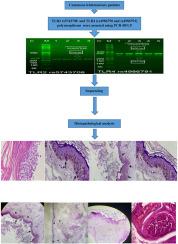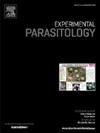TLR2 rs5743708 和 TLR4(rs4986790 和 rs4986791)多态性对皮肤利什曼病病变影响的分子和组织病理学研究。
IF 1.6
4区 医学
Q3 PARASITOLOGY
引用次数: 0
摘要
皮肤利什曼病(CL)是一种人畜共患且被忽视的疾病,流行于许多地区,尤其是热带和亚热带国家。在伊朗,特定地区存在利什曼病流行病灶,由大利什曼原虫引起的人畜共患皮肤利什曼病(ZCL)在大多数农村地区很常见。Toll 样受体(TLRs)在先天性免疫和适应性免疫中发挥着重要作用,研究寄生虫病中 TLR2 rs5743708 和 TLR4(rs4986790 和 rs4986791)的多态性对患者的治疗有重要意义。在本研究中,共有 88 名利什曼病患者在 2022 年至 2023 年期间接受了来自伊朗胡齐斯坦省医疗中心的病灶检查,其中包括 50 例(56.8%;中部地区)和 38 例(43.2%;西部地区)。每名患者的病变部位直接制备两张涂片,其中一张涂片用吉氏染色法进行寄生虫学检查。在 88 名患者中,21-30 岁年龄组的发病率最高(35.2%),11-20 岁年龄组的发病率最低(10.2%)。性别和年龄之间没有明显的统计学关系(P>0.05)。通过显微镜检查确认疾病后,使用 PCR-RFLP 评估了患者的 TLR2 rs5743708 和 TLR4(rs4986790 和 rs4986791)多态性。分别针对 TLR2 和 TLR4 基因成功扩增出 264、249 和 406 个碱基对的片段。在 88 例利什曼病患者中,有 14 例(15.9%)表现出多态性。值得注意的是,多态性组中的所有个体都同时携带 TLR2 rs5743708 同源型和 TLR4 rs4986791 杂合型基因型组合。在多态性组中没有观察到 TLR2 rs5743708 杂合子、TLR4 rs4986790 杂合子和同合子以及 TLR4 rs4986791 同合子基因型。所有贡献者的病变组织切片均准备进行组织病理学检查。与不存在多态性的患者相比,所有存在多态性的患者的病灶都较大(P 0.05)。此外,多态性患者表皮表层的一些区域出现了脓疱形成。与其他患者相比,多态性患者的真皮层没有明显差异。考虑到所有多态性患者都同时具有 TLR2 rs5743708 同源型和 TLR4 rs4986791 杂合型基因型组合,在 CL 患者皮损组织学变化中观察到的异常可能与多态性有关。然而,要全面阐明利什曼原虫的致病机理以及 TLR2 rs5743708 和 TLR4(rs4986790 和 rs4986791)基因多态性对不同地区 CL 患者的潜在影响,必须要有一个涉及更多人群的更广泛的数据集。本文章由计算机程序翻译,如有差异,请以英文原文为准。

The molecular and histopathological investigations of TLR2 rs5743708 and TLR4 (rs4986790 and rs4986791) polymorphisms effects on cutaneous leishmaniasis lesions
Cutaneous leishmaniasis (CL), a zoonotic and neglected disease, is prevalent in numerous regions, particularly in tropical and sub-tropical countries. In Iran, endemic foci of leishmaniasis exist in specific regions, with zoonotic cutaneous leishmaniasis (ZCL) caused by Leishmania major being common in most rural areas. Toll-like receptors (TLRs) play a crucial role in both innate and adaptive immunities, and the investigation of TLR2 rs5743708 and TLR4 (rs4986790 and rs4986791) polymorphisms in parasitic diseases can have significant implications for patient treatment. In the present study, a total of 88 leishmaniasis patients using the patients' lesions from Khuzestan province health-treatment centers, Iran, including 50 cases (56.8%; Central region) and 38 cases (43.2%; Western region) underwent examination between the years 2022 and 2023. Two direct smears from the lesions of each patient were prepared and one of the smears was stained with Giemsa for parasitological examination. Among the 88 patients, the highest frequency was observed in the 21–30 years' age group (35.2%), while the lowest was in the 11–20 years’ age group (10.2%). No statistically significant relationship was found between gender and age (P > 0.05). Following disease confirmation via microscopic examination, TLR2 rs5743708 and TLR4 (rs4986790 and rs4986791) polymorphisms in the patients were assessed using PCR-RFLP. Fragments of 264, 249, and 406 base pairs were successfully amplified, targeting the TLR2 and TLR4 genes, respectively. Out of the 88 leishmaniasis patients, 14 cases (15.9%) exhibited polymorphisms. Notably, all individuals in the polymorphism group carried both the TLR2 rs5743708 homozygous and the TLR4 rs4986791 heterozygous genotype combinations. There were no observations of TLR2 rs5743708 heterozygous, TLR4 rs4986790 heterozygous and homozygous and TLR4 rs4986791 homozygous genotypes within the polymorphism group. Biopsies from lesions for all contributors were prepared for histopathological examination. All patients with polymorphism showed larger lesions than patients without polymorphism (P < 0.05). Histophatological study showed abnormal cases in patients with polymorphism including mild hyperkeratosis, mild acanthosis, focal parakeratosis in the epithelium surface and mild hyperpigmentation of melanocytes in the basal layer. Furthermore, a strong infiltration of immune cells such as PMNs and a small number of lymphocytes was observed in the epidermal region of patients with polymorphisms. There was no statistically significant relationship between age and the quantity of lesions (P > 0.05). Additionally, some regions of the epidermal surface layer displayed pustule formation in patients with polymorphisms. No significant difference was discerned in the dermal layers of patients with polymorphisms compared to other patients. Considering that all patients with polymorphisms concurrently had TLR2 rs5743708 homozygous and TLR4 rs4986791 heterozygous genotype combinations, the anomalies observed in conjunction with histological changes in the skin lesions of patients with CL may plausibly be linked to the polymorphisms. Nonetheless, a more expansive dataset involving a larger population is imperative to comprehensively elucidate the pathogenesis of the Leishmania parasite and the potential impact of TLR2 rs5743708 and TLR4 (rs4986790 and rs4986791) gene polymorphisms in individuals afflicted with CL across diverse geographical locales.
求助全文
通过发布文献求助,成功后即可免费获取论文全文。
去求助
来源期刊

Experimental parasitology
医学-寄生虫学
CiteScore
3.10
自引率
4.80%
发文量
160
审稿时长
3 months
期刊介绍:
Experimental Parasitology emphasizes modern approaches to parasitology, including molecular biology and immunology. The journal features original research papers on the physiological, metabolic, immunologic, biochemical, nutritional, and chemotherapeutic aspects of parasites and host-parasite relationships.
 求助内容:
求助内容: 应助结果提醒方式:
应助结果提醒方式:


